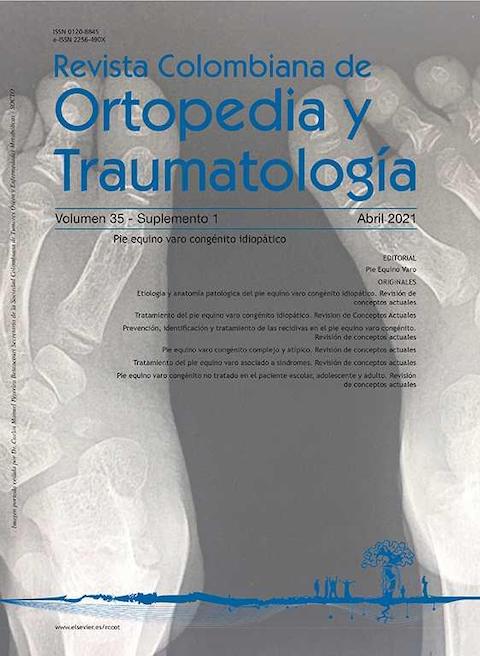Etiología y anatomía patológica del pie equino varo congénito idiopático. Revisión de conceptos actuales
DOI:
https://doi.org/10.1016/j.rccot.2021.01.001Palabras clave:
pie equino varo, talipes equinovarus, etiología, factores de riesgo, anatomía patológica, genéticaResumen
El pie equino varo congénito (PEVC) idiopático es la deformidad ortopédica más frecuente de los miembros inferiores. Su incidencia presenta variaciones geográficas y raciales. En general es de 1-2 x 1000 recién nacidos vivos. Se ha propuesto una patogénesis multifactorial. Epidemiológicamente, a pesar de la gran heterogeneidad de los estudios, los meta análisis destacan entre otros, la historia familiar y el tabaquismo, como factores asociados con la ocurrencia de PEVC. Diferentes genes han sido descubiertos con el advenimiento de nuevas técnicas de diagnóstico genético (HOX-PITX1-TBX4, entre otros) pero los casos con estas anormalidades son de rara ocurrencia y apenas explicarían el 5% de asociación hereditaria. La anatomía patológica obedece principalmente a alteraciones todavía no bien definidas de los tejidos blandos musculares, tendinosos y ligamentosos de la pierna, con el resultado de alteraciones del desarrollo muscular, neurovascular, contracturas de tejidos blandos, alteraciones secundarias óseas y articulares.
Nivel de Evidencia: IV
Descargas
Referencias bibliográficas
Kruse LM, Dobbs MB, Gurnett CA. Polygenic threshold model with sex dimorphism in clubfoot inheritance: The Carter effect. J Bone Joint Surg Am. 2012;94:1485-91, https://doi.org/10.2106/jbjs.k
Wynne-Davies R. Genetic and Environmental Factors in the Etiology of Talipes Equinovarus. Clin Orthop Relat Res. 1972;84:9-13, https://doi.org/10.1097/00003086-197205000-00003
Chen C, Kaushal N, Scher DM, Doyle SM, Blanco JS, Dodwell ER. Clubfoot Etiology: A Meta-Analysis and Systematic Review of Observational and Randomized Trials. J Pediatr Orthop. 2018;38:e462-9, https://doi.org/10.1097/BPO.0000000000001191
Hernigou P, Huys M, Pariat J, Jammal S. History of clubfoot treatment, part I: From manipulation in antiquity to splint and plaster in Renaissance before tenotomy. Int Orthop. 2017;41:1693-704, https://doi.org/10.1007/s00264-017-3487-1
Lozano AGM. Pie equino varo congénito. Tratamiento conservador: Método de Ponseti 18 Pediatría. Avances. 2006;3:18-22.
Owen RM, Kembhavi G. A critical review of interventions for clubfoot in low and middle-income countries: Effectiveness and contextual influences. Journal of Pediatric Orthopaedics Part B. 2012;21:59-67. https://doi.org/10.1097/BPB.0b013e3283499264
Anand A, Sala D. Clubfoot: etiology and treatment. Indian Journal of Orthopaedics. 2008;42:22-8. https://doi.org/10.4103/0019-5413.38576
Ochoa G. Pie equino varo congénito idiopático (Primera Parte). Rev Col Or Tra. 1996;10:27-50.
Shyy W, Dietz F, Dobbs MB, Sheffield VC, Morcuende JA. Evaluation of CAND2 and WNT7a as candidate genes for congenital idiopathic clubfoot. In: Clinical Orthopaedics and Related Research. Springer New York;. 2009:1201-5. https://doi.org/10.1007/s11999-008-0701-x
Ignacio V, Ponseti. En: Ignacio V, Ponseti, editores. Pie equino varo congénito: Fundamentos del tratamiento. 2 a . Iowa: Prensa Universitaria Oxford; 1996. p. 1-136.
Basit S, Khoshhal KI. Genetics of clubfoot; recent progress and future perspectives. Vol. 61, European Journal of Medical Genetics. Elsevier Masson SAS;. 2018:107-13. https://doi.org/10.1016/j.ejmg.2017.09.006
Pavone V, Chisari E, Vescio A, Lucenti L, Sessa G, Testa G. The etiology of idiopathic congenital talipes equinovarus: A systematic review. Vol. 13, Journal of Orthopaedic Surgery and Research. BioMed Central Ltd.;. 2018. https://doi.org/10.1186/s13018-018-0913-z
Bacino CA, Hecht JT. Etiopathogenesis of equinovarus foot malformations. European Journal of Medical Genetics. 2014;57:473-9. https://doi.org/10.1016/j.ejmg.2014.06.001
Werler MM, Yazdy MM, Mitchell AA, Meyer RE, Druschel CM, Anderka M, et al. Descriptive epidemiology of idiopathic clubfoot. American Journal of Medical Genetics, Part A. 2013;161:1569-78. https://doi.org/10.1002/ajmg.a.35955
Pavone V, Bianca S, Grosso G, Pavone P, Mistretta A, Longo MR, et al. Congenital talipes equinovarus: An epidemiological study in Sicily. Acta Orthopaedica. 2012;83:294-8. https://doi.org/10.3109/17453674.2012.678797
Kancherla V, Romitti PA, Caspers KM, Puzhankara S, Morcuende JA. Epidemiology of congenital idiopathic talipes equinovarus in Iowa, 1997-2005. American Journal of Medical Genetics, Part A. 2010;152:1695-700. https://doi.org/10.1002/ajmg.a.33481
Dickinson KC, Meyer RE, Kotch J. Maternal smoking and the risk for clubfoot in infants. Birth Defects Research Part A - Clinical and Molecular Teratology. 2008;82:86-91. https://doi.org/10.1002/bdra.20417
Honein MA, Paulozzi LJ, Moore CA. Family History, Maternal Smoking, and Clubfoot Honein et al Family History, Maternal Smoking, and Clubfoot: An Indication of a Gene-Environment Interaction. Am J Epidemiol. 2000 Oct 1;152:658-65, https://doi.org/10.1093/aje/152.7.658
Hackshaw A, Rodeck C, Boniface S. Maternal smoking in pregnancy and birth defects: A systematic review based on 173 687 malformed cases and 11.7 million controls. Human Reproduction Update. 2011;17:589-604, https://doi.org/10.1093/humupd/dmr022
Hecht JT, Ester A, Scott A, Wise CA, Iovannisci DM, Lammer EJ, et al. NAT2 variation and idiopathic talipes equinovarus (clubfoot). American Journal of Medical Genetics. Part A. 2007;143:2285-91. https://doi.org/10.1002/ajmg.a.31927
Boyle DW, Meschia G, Wilkening RB. Metabolic adaptation of fetal hindlimb to severe, nonlethal hypoxia. Am J Physiol. 1992;263:1130-5. https://doi.org/10.1152/ajpregu.1992.263.5.R1130
Serpa SC, de Melo ACMG, Gomes Lins O, van der Linden V, Leite Rolim Filho E, Oliveira dos Santos AC. Orthopedic findings in arthrogryposis and congenital Zika syndrome: A case series. Birth Defects Research. 2020;112:385-92. https://doi.org/10.1002/bdr2.1641
Salvatori G, Bettuzzi C, Abati CN, Cucca G, Zanardi A, Lampasi M. The influence of laterality, sex and family history on clubfoot severity. Journal of Children's Orthopaedics. 2020;14:145-50. https://doi.org/10.1302/1863-2548.14.190184
Werler MM, Yazdy MM, Kasser JR, Mahan ST, Meyer RE, Anderka M, et al. Medication use in pregnancy in relation to the risk of isolated clubfoot in offspring. American Journal of Epidemiology. 2014;180:86-93. https://doi.org/10.1093/aje/kwu096
Hansen M, Kurinczuk JJ, Milne E, de Klerk N, Bower C. Assisted reproductive technology and birth defects: A systematic review and meta-analysis. Human Reproduction Update. 2013;19:330-53. https://doi.org/10.1093/humupd/dmt006
Revelou MT, Eleftheriou A, Fezoulidi G, Hatzikyriakou P, Raoulis V, Tsoucalas G. Congenital orthopaedic limp deformities in Corpus Hippocraticum. International Orthopaedics. 2019;43:1993-8. https://doi.org/10.1007/s00264-019-04308-y
Handelsman J, Badalamente M. Neuromuscular studies in clubfoot. Journal of Pediatric Orthopaedics. 1981;1:23-32. https://doi.org/10.1097/01241398-198101010-00004
Loren G, Karpinski N, Mubarak S. Clinical Implications of Clubfoot Histopathology. Journal of Pediatric Orthopaedics. 1998;18:765-9. https://doi.org/10.1097/01241398-199811000-00013
Shapiro F, Glimcher M. Gross and histological abnormalities of the talus in congenital club foot. Journal of Bone and Joint Surgery - American Volume. 1979;61:522-30. https://doi.org/10.2106/00004623-197961040-00006
Gilbert JA, Roach HI, Clarke NMP. Histological abnormalities of the calcaneum in congenital talipes equinovarus. J Orthop Sci. 2001;6:519-26, https://doi.org/10.1007/s007760100007
Ionasescu V, Maynard J, Ponseti I, Zellweger H. The role of collagen in the pathogenesis of idiopathic clubfoot. Biochemical and electron microscopic correlations. Helvetica paediatrica acta. 1974;29:305-14.
Ippolito E, Ponseti I. Congenital club foot in the human fetus. A histological study, Journal of Bone and Joint Surgery (A). 1980;62:8-22. https://doi.org/10.2106/00004623-198062010-00003
Irani RN, Sherman MS. The Pathological Anatomy of Idiopatic Clubfoot. Clinical Orthopaedics and Related Research. 1972;84(May):14-20. https://doi.org/10.2106/00004623-198062010-00003
Böhm M. The embryologic origin of clubfoot. Journal of Bone and Joint Surgery. 1929;11:229.
Fukuhara K, Schollmeier G, Uhthoff H. The pathogenesis of clubfoot.A histomorphometric and immunohistochemical study of fetuses. Journal of Bone and Joint Surgery Br. 1994;76:450-7. https://doi.org/10.1302/0301-620X.76B3.8175852
Zimny M, Willing S, Roberts J, D'Ambrossia R. An electron microscopic study of the fascia from the medial and lateral sides of clubfoot. Journal of Pediatric Orthopaedics. 1985;5: 577-81. https://doi.org/10.1097/01241398-198509000-00014
Hootnick DR, Levinsohn E, Crider R, Packard D. Congenital arterial malformations associated with clubfoot. A report of two cases. Clinical Orthopaedics and Related Research. 1982;167:160-3. https://doi.org/10.1097/00003086-198207000-00022
Toydemir RM, Rutherford A, Whitby FG, Jorde LB, Carey JC, Bamshad MJ. Mutations in embryonic myosin heavy chain (MYH3) cause Freeman-Sheldon syndrome and Sheldon-Hall syndrome. Nature Genetics. 2006;38:561-5. https://doi.org/10.1038/ng1775
Sobel E, Giorgini R, Velez Z. Surgical correction of adult neglected clubfoot: Three case histories. The Journal of Foot and Ankle Surgery. 1996;35:27-38. https://doi.org/10.1016/S1067-2516(96)80009-3
Edwards MJ. The experimental production of clubfoot in guineapigs by maternal hyperthermia during gestation. Journal of Pathology. 1971;103:49-53. https://doi.org/10.1002/path.1711030107
Yang H, Chung CS, Nemechek RW. A Genetic Analysis of Clubfoot in Hawaii. Genetic Epidemiology. 1987;4:299-306, https://doi.org/10.1002/gepi.1370040408
Cowell H, Wein B. Genetic aspects of club foot. Journal of Bone and Joint Surgery - American Volume. 1980;62:1381-4. https://doi.org/10.2106/00004623-198062080-00023
Cartlidge I. Club foot in the Polynesian: an epidemiological survey. The New Zealand medical journal. 1983;96:515-7.
Ching G, Chung C, Nemechek R. Genetic and Epidemiological Studies of Clubfoot in Hawaii: Ascertainment and Incidence. Human heredity. 1969;19:321-4.
Dobbs MB, Gurnett CA. Update on clubfoot: Etiology and treatment. In: Clinical Orthopaedics and Related Research. Springer New York;. 2009:1146-53. https://doi.org/10.1007/s11999-009-0734-9
Dobbs MB, Gurnett CA. Genetics of clubfoot. Vol. 21, Journal of Pediatric Orthopaedics Part B. 2012:7-9. https://doi.org/10.1097/BPB.0b013e328349927c
Rosselli P. Pie equino Varo Congénito. En: Rosselli P, Duplat JL, editores. Ortopedia Infantil. 2nd ed. Bogotá: Editorial Médica Panamericana; 2012. p. 495-510.
Pirani S, Zeznik L, Hodges D. Magnetic Resonance Imaging Study of the Congenital Clubfoot Treated With the Ponseti Method. J. Pediatr Orthop. 2001;21:719-26. https://doi.org/10.1097/01241398-200111000-00004
Scarpa A. A memoir on the congenital club feet of children, and of the mode of correcting that deformity. Clinical Orthopaedics and Related Research. 1994;308:4-7. https://doi.org/10.1097/00003086-199411000-00002
Ippolito E, Dragoni M, Antonicoli M, Farsetti P, Simonetti G, Masala S, An MRI. volumetric study for leg muscles in congenital clubfoot. Journal of Children's Orthopaedics. 2012;6:433-8. https://doi.org/10.1007/s11832-012-0444-9
Ippolito E. Update on pathologic anatomy of clubfoot. Journal of Pediatric Orthopaedics B. 1995;4:17-24. https://doi.org/10.1097/01202412-199504010-00003
Dobbs MB, Gurnett CA. The 2017 ABJS Nicolas Andry Award: Advancing Personalized Medicine for Clubfoot Through Translational Research. Clinical Orthopaedics and Related Research. 2017;475:1716-25. https://doi.org/10.1007/s11999-017-5290-0
Porter RW. An Anomalous Muscle in Children With Congenital Talipes. Vol. 9. Clinical Anatomy. 1996. https://doi.org/ftzk9n
Abo El-Fadl SM. An Unusual Aberrant Muscle in Congenital Clubfoot: An Intraoperative Finding. Journal of Foot and Ankle Surgery. 2013;52:380-2. https://doi.org/10.1053/j.jfas.2012.12.012
Puri AMC, Hughes KP, Stenson KM, Gelfer Y, Holt PJE, Patterson BO. Variations in arterial pedal circulation in idiopathic congenital talipes equinovarus. Journal of Pediatric Orthopaedics B. 2020;30:59-65, https://doi.org/10.1097/BPB.0000000000000724
Ponseti I, Campos J, Brand R. The Classic Observations on Pathogenesis and Treatment of Congenital Clubfoot. Clin Orthop Relat Res. 2009;467:1124-32. https://doi.org/10.1007/s11999-009-0721-1









